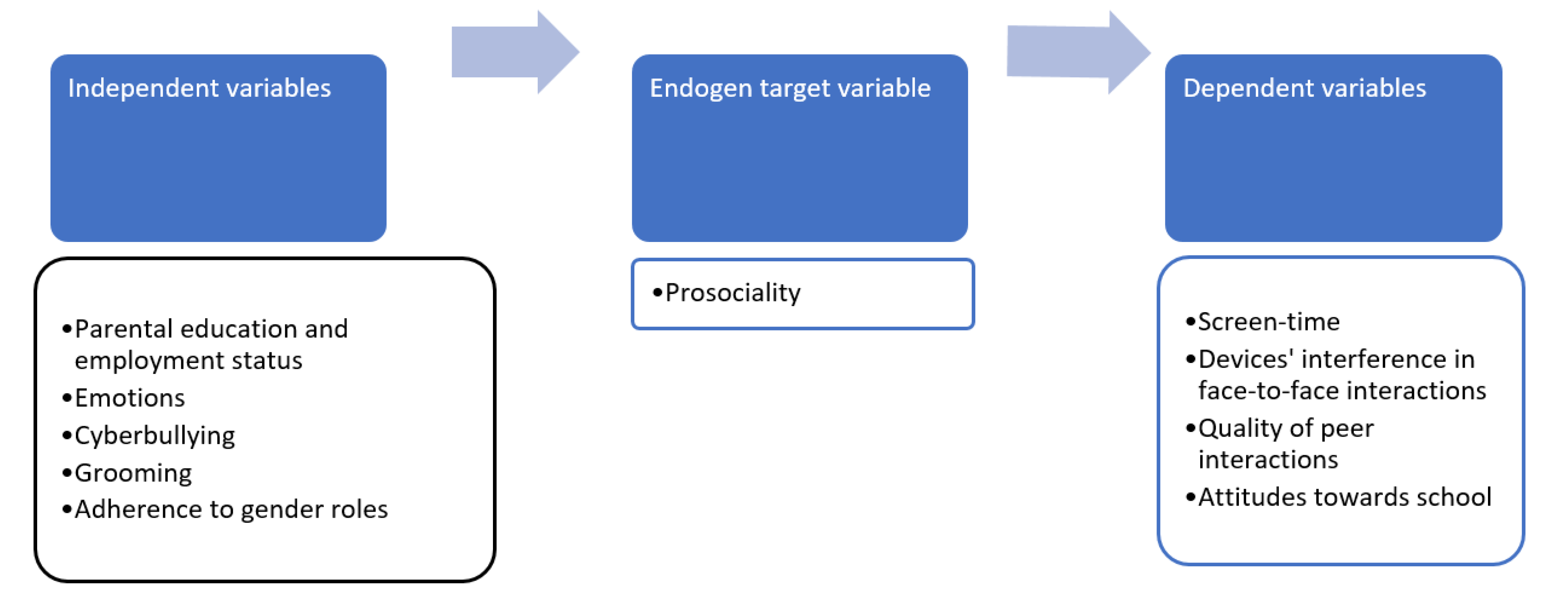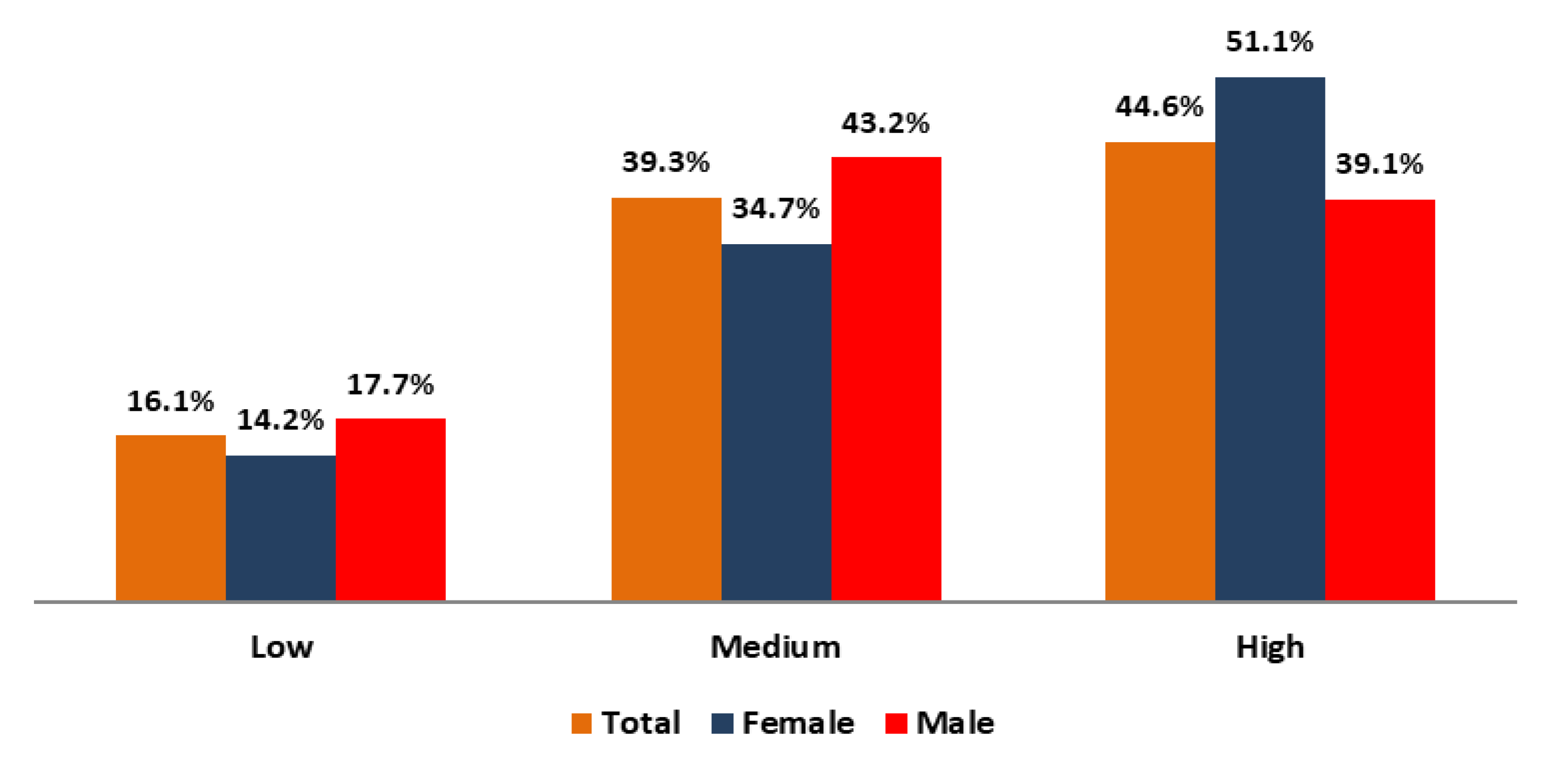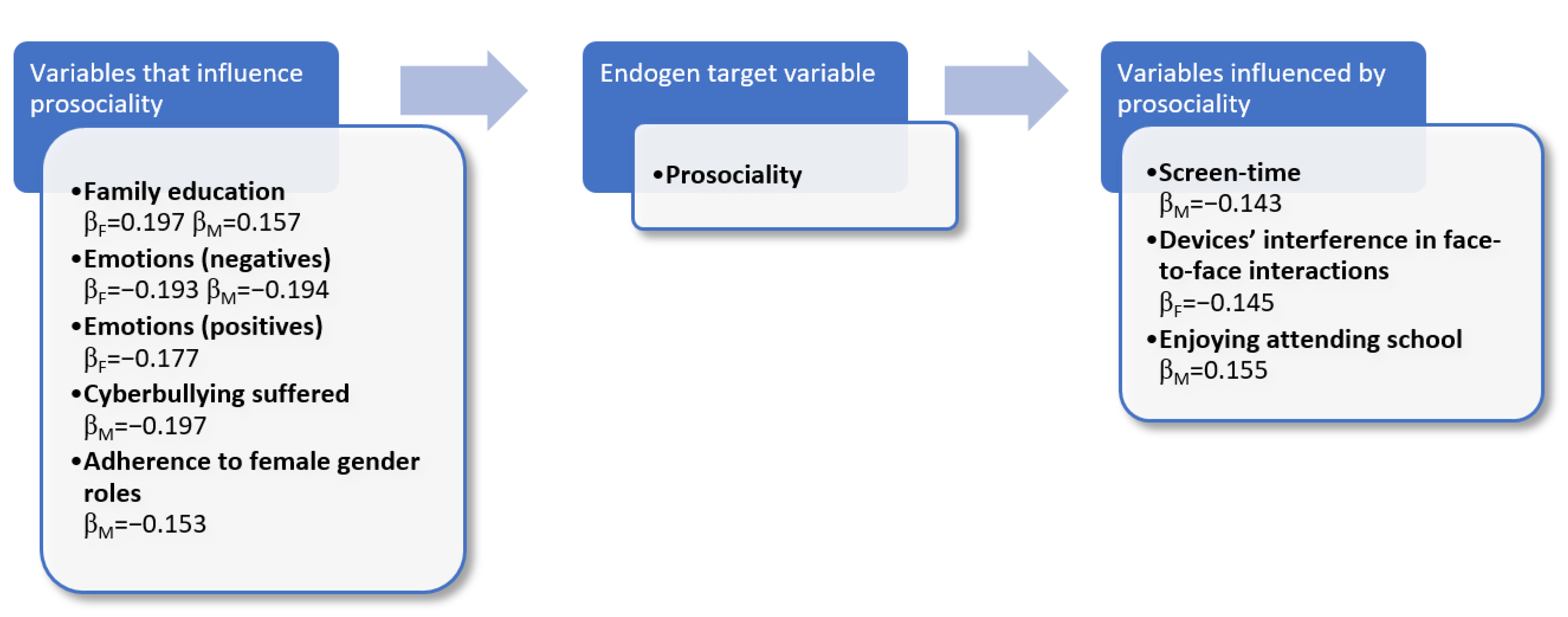The Impact of Socialisation on Children’s Prosocial Behaviour. A Study on Primary School Students
Abstract
:1. Introduction and Objectives
2. Methodology
2.1. Participants
2.2. Data Collection Tools
- −
- Quantity and quality of social interaction among peers;
- −
- Screen time;
- −
- Cyberbullying, sexting, online grooming;
- −
- Well-being;
- −
- Social attitudes and behaviours.
- −
- Vertical and horizontal social interactions (leisure, sports, relational trust);
- −
- Online events and behaviours;
- −
- Electronic devices used and purposes and time of use;
- −
- Favourite video games;
- −
- Favourite social media;
- −
- Individual status in relation to the use of electronic devices, video games and social media;
- −
- Prosocial tendencies and behaviours;
- −
- Gender stereotypes.
2.3. Procedures
2.4. Data Analysis
3. Results
3.1. Results of the Bivariate Statistical Analysis
3.2. Results of the Path Analysis Model
4. Discussion
5. Conclusions
Author Contributions
Funding
Institutional Review Board Statement
Informed Consent Statement
Data Availability Statement
Conflicts of Interest
Appendix A. Additional Materials
|
| I can help |
| I can avoid bothering him/her |
| I can steer clear from him/her to avoid trouble |
| It is useless, it is not my business |
|
| Make a kind action |
| Tell him/her in person |
| Text him/her |
| Just think about it, because I am ashamed to say it openly |
|
| From the tone of his/her voice |
| From his/her posture |
| From his/her facial expression |
| From the gestures he/she makes |
References
- Eisenberg, N. Altruistic Emotion, Cognition and Behavior; Erlbaum: Hillsdale, NJ, USA, 1986. [Google Scholar]
- Jenesen, K. Prosociality. Curr. Biol. 2016, 26, R748–R752. [Google Scholar] [CrossRef]
- Warneken, F.; Tomasello, M. The roots of human altruism. Br. J. Psychol. 2009, 100, 455–471. [Google Scholar] [CrossRef] [Green Version]
- Strayer, F.F.; Wareing, S.; Rushton, J.P. Social constraints on naturally occurring preschool altruism. Ethol. Sociobiol. 1979, 1, 3–11. [Google Scholar] [CrossRef]
- Müssen, P.; Eisenberg, N. The Roots of Caring, Sharing, and Helping; Freeman: San Francisco, CA, USA, 1977; pp. 3–4. [Google Scholar]
- Available online: https://books.google.com.hk/books?id=10XxMWxJC7oC&pg=PA6&lpg=PA6&dq=Il+Comportamento+Prosociale:+Aspetti+Individuali,+Familiari+e+Sociali&source=bl&ots=UaHRs2jLe5&sig=ACfU3U3xqKQGlF5O6MFqO7pfNWjsRY9s5Q&hl=zh-CN&sa=X&ved=2ahUKEwi25O_Frpz0AhXhsFYBHRPuA9I4ChDoAXoECAwQAw#v=onepage&q=Il%20Comportamento%20Prosociale%3A%20Aspetti%20Individuali%2C%20Familiari%20e%20Sociali&f=false (accessed on 15 April 2020).
- Roche Olivar, R. Prosocialidad, Nuevos Desafíos: Métodos y Pautas Para la Optimización Creativa del Entorno; Ciudad Nueva: Buenos Aires, Argentina, 2010. [Google Scholar]
- Miles, S.; Stipek, D. Contemporaneous and Longitudinal Associations between Social Behavior and Literacy Achievement in a Sample of Low-Income Elementary School Children. Child Dev. 2006, 77, 103–117. [Google Scholar] [CrossRef] [PubMed]
- Caprara, G.V.; Barbaranelli, C.; Pastorelli, C.; Bandura, A.; Zimbardo, P.G. Prosocial Foundations of Children’s Academic Achievement. Psychol. Sci. 2000, 11, 302–306. [Google Scholar] [CrossRef]
- Steca, P.; Caprara, M.G. Prosocialità e benessere individuale nell’arco di vita. In Il Comportamento Prosociale; Caprara, G.V., Bonino, S., Eds.; Erickson: Trento, Italy, 2006; pp. 209–221. [Google Scholar]
- Lucca, K.; Pospisil, J.; Sommerville, J.A. Fairness informs social decision making in infancy. PLoS ONE 2018, 13, e0192848. [Google Scholar] [CrossRef] [PubMed]
- Hoffman, M.L. Empathy and Moral Development: Implications for Caring and Justice; Cambridge University Press: Cambridge, UK, 2000. [Google Scholar]
- Vaish, A.; Carpenter, M.; Tomasello, M. Sympathy through Affective Perspective Taking and Its Relation to Prosocial Behavior in Toddlers. Dev. Psychol. 2009, 45, 534–543. [Google Scholar] [CrossRef]
- Van den Bos, W.; Van Dijk, E.; Westenberg, M.; Rombouts, S.A.R.B.; Crone, E.A. Changing brains, changing perspectives: The neurocognitive development of reciprocity. Psychol. Sci. 2011, 22, 60–70. [Google Scholar] [CrossRef] [Green Version]
- Eisenberg, N.; Fabes, R.A.; Spinrad, T.L. Prosocial Development. In Handbook of Child Psychology: Social, Emotional, and Personality Development; Eisenberg, N., Damon, W., Lerner, R.M., Eds.; John Wiley & Sons, Inc.: Hoboken, NJ, USA, 2006; pp. 646–718. [Google Scholar]
- Eisenberg, N.; Miller, P.; Shell, R.; McNalley, S.; Shea, C. Prosocial Development in Adolescence: A Longitudinal Study. Dev. Psychol. 1991, 27, 849–857. [Google Scholar] [CrossRef]
- Vecchione, M.; Picconi, L. Differenze di genere nella condotta prosociale. In Il Comportamento Prosociale. Aspetti Individuali, Familiari e Social; Caprara, G.V., Bonino, S., Eds.; Centro Studi Erickson: Trento, Italy, 2006. [Google Scholar]
- Flook, L.; Zahn-Waxler, C.; Davidson, R.J. Developmental differences in prosocial behaviour between preschool and late elementary school. Front. Psychol. 2019, 10, 876. [Google Scholar] [CrossRef]
- Foulkes, L.; Leung, J.T.; Fuhrmann, D.; Knoll, L.J.; Blakemore, S.J. Age differences in the prosocial influence effect. Dev. Sci. 2018, 21, e12666. [Google Scholar] [CrossRef] [PubMed] [Green Version]
- Anderson, C.A.; Shibuya, A.; Ihori, N.; Swing, B.J.; Bushman, E.L.; Sakamoto, A.; Saleem, M. Violent video game effects on aggression, empathy, behavior in eastern and western countries: A meta-analytic review. Psychol. Bull. 2010, 136, 151–173. [Google Scholar] [CrossRef] [PubMed] [Green Version]
- Sanders, T.; Parker, P.D.; del Pozo-Cruz, B.; Noetel, M.; Lonsdale, C. Type of screen time moderate effects on outcomes in 4013 children: Evidence from the Longitudinal Study of Australian Children. Int. J. Behav. Nutr. Phys. Act 2019, 16, 117. [Google Scholar] [CrossRef] [PubMed]
- Zhao, J.; Zhang, Y.; Jiang, F.; Ip, P.K.; Ho, F.; Zhang, Y.; Huanq, H. Excessive Screen Time and Psychosocial Well-Being: The Mediating Role of Body Mass Index, Sleep Duration, and Parent-Child Interaction. J. Pediatr. 2018, 202, 157–162.e1. [Google Scholar] [CrossRef]
- Ferguson, C.J. Do Angry Birds Make for Angry Children? A Meta-Analysis of Video Game Influences on Children’s and Adolescents’ Aggression, Mental Health, Prosocial Behavior, and Academic Performance. Perspect. Psychol. Sci. 2015, 10, 646–666. [Google Scholar] [CrossRef] [PubMed]
- Carlo, G. Care-based and altruistically based morality. In Handbook of Moral Development; Killen, M., Smetana, J.G., Eds.; Erlbaum: Mahwah, NJ, USA, 2006; pp. 551–579. [Google Scholar]
- Eagly, A.H.; Crowley, M. Gender and helping behavior: A meta-analytic review of the social psychological literature. Psychol. Bull. 1986, 100, 283–308. [Google Scholar] [CrossRef]
- Carlo, G.; Randall, B.A. The development of a measure of prosocial behaviors for late adolescents. J. Youth Adolesc. 2002, 31, 31–44. [Google Scholar] [CrossRef]
- Gilligan, C. In a Different Voice: Psychological Theory and Women’s Development; Harvard University Press: Cambridge, MA, USA, 1982. [Google Scholar]
- Witt, S.D. Parental influence on children’s socialization to gender roles. Adolescence 1997, 32, 253–259. [Google Scholar]
- Hussain, M.; Naz, A.; Khan, W.; Daraz, U.; Khan, Q. Gender stereotyping in family: An institutionalized and normative mechanism in Pakhtun Society of Pakistan. SAGE Open 2015, 5, 2158244015595258. [Google Scholar] [CrossRef]
- Newman, L.K. Sex, gender and culture: Issues in the definition, assessment and treatment of gender identity disorder. Clin. Child Psychol. Psychiatry 2002, 7, 352–359. [Google Scholar] [CrossRef]
- Shen-Miller, D.S.; Olson, D.; Boling, T. Masculinity in nontraditional occupations: Ecological constructions. Am. J. Men’s Health 2011, 5, 18–29. [Google Scholar] [CrossRef] [PubMed] [Green Version]
- Baker, E.R.; Tisak, M.S.; Tisak, J. What can boys and girls do? Preschoolers’ perspectives regarding gender roles across domains of behavior. Soc. Psychol. Educ. 2016, 19, 23–39. [Google Scholar] [CrossRef]
- Siyanova-Chanturia, A.; Warren, P.; Pesciarelli, F.; Cacciari, C. Gender stereotypes across the ages: On-line processing in school-age children, young and older adults. Front. Psychol. 2015, 6, 1388. [Google Scholar] [CrossRef] [Green Version]
- Hastings, P.D.; Utendale, W.T.; Sullivan, C. The socialization of prosocial development. In The Handbook of Socialization: Theory and Research; Grusec, J., Hastings, P.D., Eds.; Guilford Press: New York, NY, USA, 2007; pp. 638–664. [Google Scholar]
- Cao, B.; Lin, W.-Y. How do victims react to cyberbullying on social networking sites? The influence of previous cyberbullying victimization experiences. Comput. Hum. Behav. 2015, 52, 458–465. [Google Scholar] [CrossRef]
- Menesini, E.; Modena, M.; Tani, F. Bullying and victimization in adolescence: Concurrent and stable roles and psychological health symptoms. J. Genet. Psychol. 2009, 170, 115–134. [Google Scholar] [CrossRef] [PubMed]
- Heirman, W.; Walrave, M. Predicting adolescent perpetration in cyberbullying: An application of the theory of planned behaviour. Psicothema 2012, 24, 614–620. [Google Scholar]
- Andreoni, J.; Nikiforakis, N.; Stoop, J. Higher socioeconomic status does not predict decreased prosocial behavior in a field experiment. Nat. Commun. 2021, 12, 4266. [Google Scholar] [CrossRef]
- Robinson, A.R.; Piff, P.K. Deprived, but not depraved: Prosocial behavior is an adaptive response to lower socioeconomic status. Behav. Brain Sci. 2017, 40, e341. [Google Scholar] [CrossRef]
- Piff, P.K.; Kraus, M.W.; Côté, S.; Cheng, B.H.; Keltner, D. Having less, giving more: The influence of social class on prosocial behavior. J. Personal. Soc. Psychol. 2010, 99, 771–784. [Google Scholar] [CrossRef] [PubMed] [Green Version]
- Kosse, F.; Deckers, T.; Pinger, P.; Schildberg-Hörisch, H.; Falk, A. The formation of prosociality: Causal evidence on the role of social environment. J. Political Econ. 2020, 128, 434–467. [Google Scholar] [CrossRef] [Green Version]
- Benenson, J.F.; Pascoe, J.; Radmore, N. Children’s altruistic behavior in the dictator game. Evol. Hum. Behav. 2007, 28, 168–175. [Google Scholar] [CrossRef]
- Angerer, S.; Glätzle-Rützler, D.; Lergetporer, P.; Sutter, M. Donations, risk attitudes and time preferences: A study on altruism in primary school children. J. Econ. Behav. Organ. 2015, 115, 67–74. [Google Scholar] [CrossRef] [Green Version]
- Schmukle, S.C.; Korndörfer, M.; Egloff, B. No evidence that economic inequality moderates the effect of income on generosity. Proc. Natl. Acad. Sci. USA 2019, 116, 9790–9795. [Google Scholar] [CrossRef] [PubMed] [Green Version]
- Korndörfer, M.; Egloff, B.; Schmukle, S.C. A Large-Scale Test of the Effect of Social Class on Prosocial Behavior. PLoS ONE 2015, 20, e0133193. [Google Scholar] [CrossRef] [PubMed]
- Ye, Y.; Long, T.; Liu, C.; Xu, D. The Effect of Emotion on Prosocial Tendency: The Moderating Effect of Epidemic Severity under the Outbreak of COVID-19. Front. Psychol. 2020, 11, 588701. [Google Scholar] [CrossRef] [PubMed]
- Edwards, A.; Eisenberg, N.; Spinrad, T.L.; Reiser, M.; Eggum-Wilkens, N.D.; Liew, J. Predicting sympathy and prosocial behavior from young Children’s dispositional sadness: Predicting sympathy and prosocial behavior. Soc. Dev. 2015, 24, 76–94. [Google Scholar] [CrossRef] [Green Version]
- UN Policy Brief: The Impact of COVID-19 on Children. Available online: https://unsdg.un.org/sites/default/files/2020-04/160420_Covid_Children_Policy (accessed on 15 April 2020).
- Orben, A.; Tomova, L.; Blakemore, S.-J. The effects of social deprivation on adolescent development and mental health. Lancet Child Adolsc. Health 2020, 4, 634–640. [Google Scholar] [CrossRef]
- Xie, X.; Xue, Q.; Zhou, Y. Mental Health Status Among Children in Home Confinement During the Coronavirus Disease, Outbreak in Hubei Province, China. JAMA Pediatr. 2020, 174, e201619. [Google Scholar] [CrossRef] [PubMed] [Green Version]
- Jiao, W.Y.; Wang, L.N.; Liu, J.; Fang, S.F.; Jiao, F.Y.; Pettoello-Mantovani, M.; Somekh, E. Behavioral and Emotional Disorders in Children during the COVID-19 Epidemic. J. Pediatr. 2020, 221, 264–266.e1. [Google Scholar] [CrossRef]
- Tso, W.W.; Wong, R.S.; Tung, K.T.; Rao, N.; Fu, K.W.; Yam, J.C.; Chua, G.T.; Chen, E.Y.; Lee, T.M.; Chan, S.K. Vulnerability and resilience in children during the COVID-19 pandemic. Eur. Child Adolesc. Psychiatry 2020, in press. [Google Scholar] [CrossRef]
- Pisano, L.; Galimi, D.; Cerniglia, L. A qualitative report on exploratory data on the possible emotional/behavioral correlates of Covid-19 lockdown in 4–10 years children in Italy. PsyArXiv 2020. [Google Scholar] [CrossRef]
- Orgilés, M.; Morales, A.; Delvecchio, E.; Mazzeschi, C.; Espada, J.P. Immediate psychological effects of the COVID-19 quarantine in youth from Italy and Spain. Front. Psychol. 2020, 11, 2986. [Google Scholar] [CrossRef]
- Spinelli, M.; Lionetti, F.; Pastore, M.; Fasolo, M. Parents’ Stress and Children’s Psychological Problems in Families Facing the COVID-19 Outbreak in Italy. Front. Psychol. 2020, 11, 1713. [Google Scholar] [CrossRef] [PubMed]
- Uccella, S.; De Grandis, E.; De Carli, F.; D’Apruzzo, M.; Siri, L.; Preiti, D.; Di Profio, S.; Rebora, S.; Cimellaro, P.; Biolcati Rinaldi, A.; et al. Impact of the COVID-19 Outbreak on the Behavior of Families in Italy: A Focus on Children and Adolescents. Front. Public Health 2021, 9, 608358. [Google Scholar] [CrossRef]
- Segre, G.; Campi, R.; Scarpellini, F.; Clavenna, A.; Zanetti, M.; Cartabia, M.; Bonati, M. Interviewing children: The impact of the COVID-19 quarantine on children’s perceived psychological distress and changes in routine. BMC Pediatr. 2021, 21, 231. [Google Scholar] [CrossRef] [PubMed]
- Tintori, A.; Ciancimino, G.; Oksay, A.; Senal, S.; Bulgan, G.; Büyüker İşler, D.; Cerbara, L. Comparing the influence of gender stereotypes on well-being in Italy and Turkey during the COVID-19 lockdown. Eur. Rev. Med. Pharmacol. Sci. 2020, 24, 13037–13043. [Google Scholar] [PubMed]
- Williams, L.J.; James, L.R. Causal models in organizational behavior research: From path analysis to LISREL and beyond. In Organizational Behavior; Greenberg, J., Ed.; Routledge: London, UK, 1994; pp. 191–216. [Google Scholar]
- Wright, S. The method of path coefficients. Ann. Math. Stat. 1934, 5, 161–215. [Google Scholar] [CrossRef]
- Kaplan, D. Structural Equation Modeling Foundations and Extensions, 2nd ed.; Series: Advanced Quantitative Techniques in the Social Sciences; SAGE Publications, Inc.: Thousand Oacs, CA, USA, 2009. [Google Scholar]
- Lomax, R.G. A guide to LISREL-type structural equation modelling. Behav. Res. Methods Instrum. 1982, 14, 1–8. [Google Scholar] [CrossRef] [Green Version]



Publisher’s Note: MDPI stays neutral with regard to jurisdictional claims in published maps and institutional affiliations. |
© 2021 by the authors. Licensee MDPI, Basel, Switzerland. This article is an open access article distributed under the terms and conditions of the Creative Commons Attribution (CC BY) license (https://creativecommons.org/licenses/by/4.0/).
Share and Cite
Tintori, A.; Ciancimino, G.; Palomba, R.; Clementi, C.; Cerbara, L. The Impact of Socialisation on Children’s Prosocial Behaviour. A Study on Primary School Students. Int. J. Environ. Res. Public Health 2021, 18, 12017. https://doi.org/10.3390/ijerph182212017
Tintori A, Ciancimino G, Palomba R, Clementi C, Cerbara L. The Impact of Socialisation on Children’s Prosocial Behaviour. A Study on Primary School Students. International Journal of Environmental Research and Public Health. 2021; 18(22):12017. https://doi.org/10.3390/ijerph182212017
Chicago/Turabian StyleTintori, Antonio, Giulia Ciancimino, Rossella Palomba, Cristiana Clementi, and Loredana Cerbara. 2021. "The Impact of Socialisation on Children’s Prosocial Behaviour. A Study on Primary School Students" International Journal of Environmental Research and Public Health 18, no. 22: 12017. https://doi.org/10.3390/ijerph182212017
APA StyleTintori, A., Ciancimino, G., Palomba, R., Clementi, C., & Cerbara, L. (2021). The Impact of Socialisation on Children’s Prosocial Behaviour. A Study on Primary School Students. International Journal of Environmental Research and Public Health, 18(22), 12017. https://doi.org/10.3390/ijerph182212017







